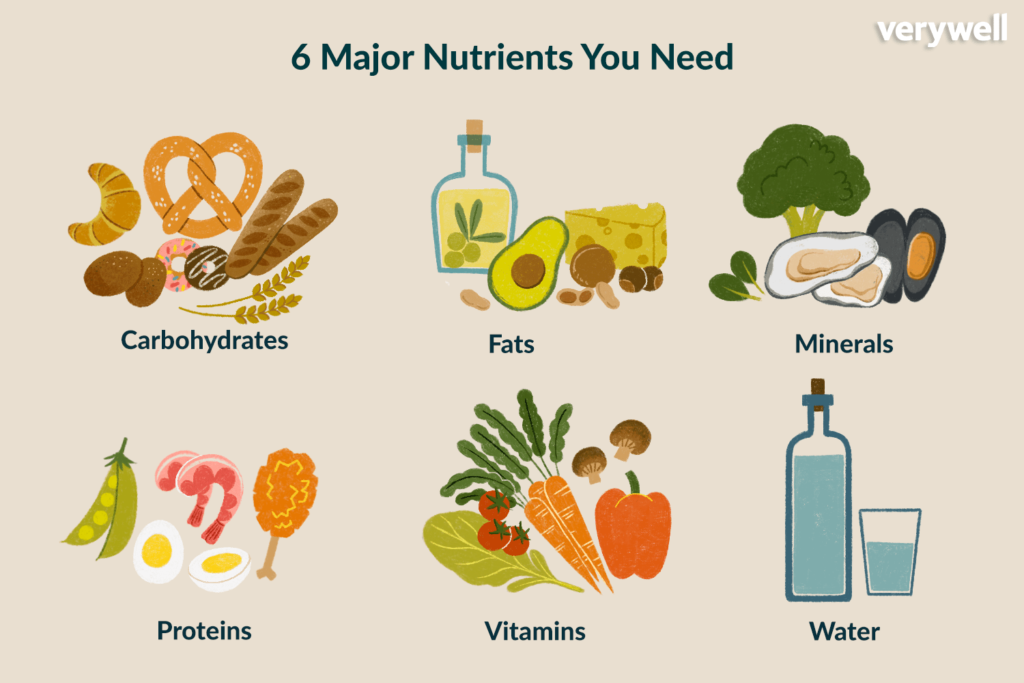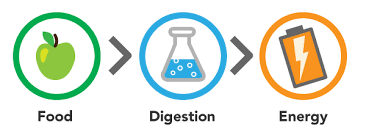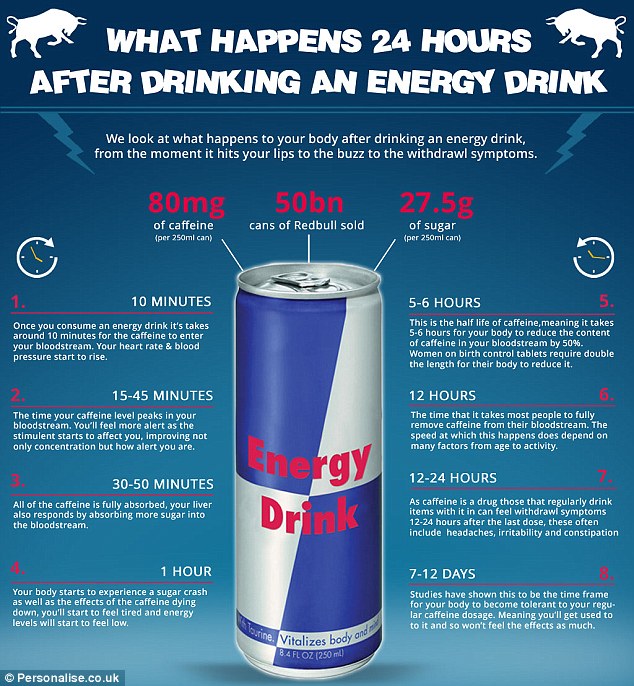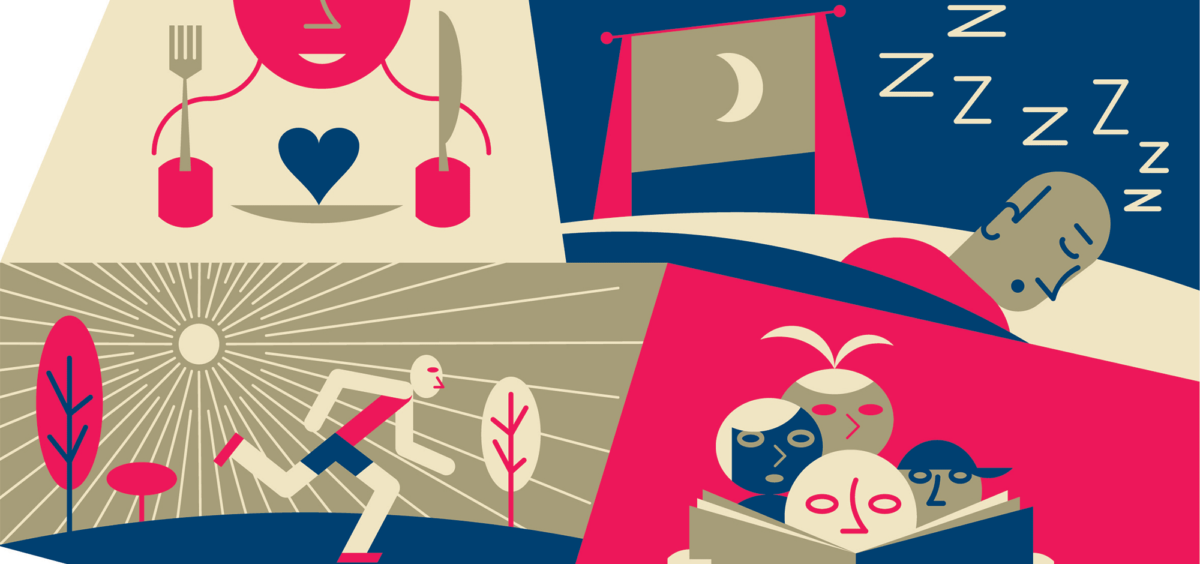The Science is complicated
The human body’s energy system converts food into energy through a process called cellular respiration. The primary source of energy for the body is glucose, which is broken down in the mitochondria of cells to produce ATP (adenosine triphosphate), the main source of energy for the body’s cells. The body also has backup energy systems, such as glycogen stored in the liver and muscle tissue, and fat stores, which can be broken down into fatty acids and used for energy when glucose is in short supply. The body also uses oxygen during cellular respiration to release energy from glucose and other fuel sources.
Other Important energy sources include:
-
-
- Glycogen: Stored glycogen in the liver and muscles can be broken down into glucose to provide energy.
- Fat: Fatty acids can be broken down in the mitochondria to produce ATP. This process, known as beta-oxidation, provides a long-term energy source.
- Proteins: When glucose and glycogen stores are depleted, the body can break down amino acids from proteins to produce glucose through a process called gluconeogenesis.
- Ketones: During periods of low glucose availability, such as during fasting or low-carbohydrate diets, the liver can produce ketones from fatty acids, which can be used as an alternative energy source by the brain and other tissues.
-

Overall, the body is capable of using a variety of energy sources to meet its needs and maintain homeostasis. “Homeostasis” for our bodies means the optimal maintenance of a constant internal environment such as temperature, pH, water balance, and blood glucose levels, despite fluctuations in the external environment i.e. coordinated actions of various organ systems and hormones, which work together to regulate various physiological processes and keep the internal environment within a narrow range of values.
What are the main draws from the Body’s energy system?
Overall, the body’s energy needs are influenced by a variety of factors, including age, sex, body size, and physical activity level, as well as internal factors, such as hormonal regulation and the body’s metabolic rate.
How the Top 5 are:
-
-
- Physical activity: Energy is required for movement, exercise, and other forms of physical activity.
- Basal metabolic rate: The basal metabolic rate is the energy needed to maintain basic physiological functions, such as breathing, circulation, and the maintenance of body temperature.
- Thermoregulation: Energy is required to regulate body temperature, especially in response to changes in the external environment.
- Growth and repair: Energy is required for the growth and repair of tissues, as well as for the production of new cells.
- Mental activity: Energy is required for the processes of thinking, reasoning, and memory formation, as well as for the regulation of mood and emotions.
-

These are the everyday aspects that reduce or use up our energy levels, but there are the “enemies” of the system which we must be aware of and manage, they include:
-
-
- Lack of sleep: Poor sleep quality and lack of sleep can lead to fatigue, decreased energy levels, and decreased ability to perform physical and mental tasks.
- Poor nutrition: A diet low in nutrients and high in processed foods can lead to low energy levels and decreased ability to perform physical and mental tasks.
- Stress: Chronic stress can lead to increased levels of the stress hormone cortisol, which can cause fatigue, decreased energy levels, and decreased ability to perform physical and mental tasks.
- Dehydration: Dehydration can cause fatigue, decreased energy levels, and decreased ability to perform physical and mental tasks.
- Sedentary lifestyle: A lack of physical activity and prolonged sitting can lead to decreased energy levels, decreased cardiovascular and muscular fitness, and increased risk of chronic diseases.
-
It is important to maintain a healthy lifestyle and habits, such as eating a balanced diet, getting enough sleep, reducing stress, staying hydrated, and engaging in regular physical activity, to support optimal energy levels and overall health.
Do male & female bodies work the same?
Men and women have some differences in their energy systems, although the basic principles of energy production and utilization are the same in both sexes. Some of the differences between men and women include:
-
-
- Body composition: Men generally have a higher percentage of muscle mass and a lower percentage of body fat than women, which can impact energy utilization and storage.
- Hormonal differences: Hormonal differences between men and women, such as differences in testosterone and estrogen levels, can impact energy utilization and storage.
- Metabolic rate: On average, men have a higher metabolic rate than women, meaning they burn more calories at rest.
- Physical activity patterns: Men and women may engage in different types and amounts of physical activity, which can impact energy utilization and storage.
- Energy needs during pregnancy: During pregnancy, women have increased energy needs to support the growth and development of the fetus.
-
What happens to our energy system as we grow older?

As you would expect and have experienced as we grow older, there are several changes that occur in the body’s energy system, including:
-
-
- Decreased muscle mass: With age, there is a decline in muscle mass, which can lead to a decrease in the body’s metabolic rate and an increase in the amount of body fat.
- Hormonal changes: Hormonal changes with age, such as a decline in testosterone and estrogen levels, can impact energy utilization and storage.
- Decreased physical activity: With age, there is often a decline in physical activity, which can lead to decreased energy utilization and decreased cardiovascular and muscular fitness.
- Changes in dietary needs: With age, there may be changes in dietary needs, such as an increased need for certain nutrients, which can impact energy utilization and storage.
- Chronic health conditions: Chronic health conditions, such as heart disease, diabetes, and obesity, can impact energy utilization and storage.
-
What does the “ideal world look like for our energy system”?

If we lived in an ideal world, we would live in a way that helps the body maximize its energy system by:
-
-
- Eating a balanced diet: Consuming a diet rich in fruits, vegetables, whole grains, lean protein, and healthy fats can provide the body with the nutrients it needs to support energy production and utilization.
- Getting adequate sleep: Aiming for 7-9 hours of quality sleep per night can help to support optimal energy levels and overall health.
- Engaging in regular physical activity: Regular physical activity, such as aerobic exercise and resistance training, can help to maintain muscle mass, improve cardiovascular and muscular fitness, and support energy utilization.
- Reducing stress: Engaging in stress management techniques, such as meditation, yoga, and deep breathing, can help to reduce stress and support energy levels.
- Staying hydrated: Drinking enough water throughout the day can help to support energy levels and overall health.
- Avoiding harmful habits: Avoiding habits that can be harmful to energy levels and overall health, such as smoking, excessive alcohol consumption, and drug use, is important.
-
In an ideal world, individuals would have access to the resources they need to maintain a healthy lifestyle, including healthy food options, safe and accessible physical activity opportunities, and supportive communities. By making lifestyle choices that support optimal energy levels and overall health, individuals can live in a way that helps the body maximize its energy system.
Your body will tell you when it is having a tough time.

Here are the top 5 signs that you may be low on energy levels:
-
-
- Fatigue: Feeling tired and having a lack of energy is a common sign of low energy levels.
- Decreased physical activity: When you have low energy levels, you may be less active and less motivated to exercise.
- Difficulty concentrating: Low energy levels can make it difficult to focus and concentrate on tasks.
- Irritability and mood swings: Low energy levels can cause changes in mood and increase feelings of irritability.
- Changes in sleep patterns: Low energy levels can cause changes in sleep patterns, including difficulty falling asleep or staying asleep, or feeling drowsy during the day.
-
If you are experiencing any of these symptoms, it is important to seek guidance from a healthcare professional to determine the underlying cause of your low energy levels and to receive appropriate treatment and support. Making lifestyle changes, such as eating a healthy diet, getting adequate sleep, engaging in regular physical activity, and reducing stress, can also help to support optimal energy levels and overall health.
How can I get a “quick fix”?
Here are some food and drinks that can provide a short-term energy boost:
-
-
- Caffeine: Caffeine is a stimulant that can help to increase alertness and focus. Common sources of caffeine include coffee, tea, and energy drinks.
- Simple carbohydrates: Foods high in simple carbohydrates, such as candy, pastries, and sugary drinks, can provide a quick burst of energy by increasing blood sugar levels.
- Bananas: Bananas are a good source of natural sugars and potassium, which can help to support energy levels.
- Nuts and seeds: Nuts and seeds are good sources of healthy fats, protein, and fiber, which can help to provide sustained energy.
- Whole grains: Whole grain foods, such as whole grain bread and pasta, provide a slow release of energy and can help to maintain blood sugar levels throughout the day.
-
It is important to keep in mind that while these foods and drinks can provide a short-term energy boost, they should be consumed in moderation as part of a balanced diet, and should not replace a healthy diet and lifestyle that supports optimal energy levels and overall health.
Additionally, some of these food and drink options, such as caffeine and sugar, can have negative impacts on health if consumed in excess, so it’s important to consult with a healthcare professional for guidance on what is best for you.
LASTLY…
Energy Drinks – Avoid them, no really don’t if you don’t have to.

Energy drinks should be viewed with caution, as they can have negative impacts on health if consumed in excess. Energy drinks contain high levels of caffeine and sugar, which can lead to increased heart rate, increased blood pressure, and dehydration. They can also disrupt sleep patterns and lead to feelings of anxiety and jitters.
Additionally, energy drinks can be addictive, and overconsumption can lead to tolerance, requiring higher and higher doses to achieve the same effects. Regular consumption of energy drinks can also increase the risk of chronic health problems, such as obesity, type 2 diabetes, and heart disease.
It is recommended to limit the consumption of energy drinks and to seek alternative sources of energy, such as a balanced diet and regular physical activity, to support optimal energy levels and overall health. If you choose to consume energy drinks, it is important to do so in moderation and to consult with a healthcare professional for guidance on what is best for you.

